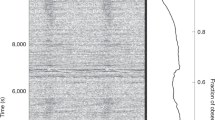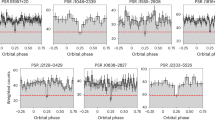Abstract
DURING the period July 26 to September 21, 1972, the Jodrell Bank Mark IA radio telescope has been engaged in a systematic search for pulsars at a frequency of 408 MHz. The technique is that used by Davies, Large and Pickwick1 in 1970, but adapted in a way that allows the analysis to be carried out in real time on the Argus data processing computer.
This is a preview of subscription content, access via your institution
Access options
Subscribe to this journal
Receive 51 print issues and online access
$199.00 per year
only $3.90 per issue
Buy this article
- Purchase on Springer Link
- Instant access to full article PDF
Prices may be subject to local taxes which are calculated during checkout
Similar content being viewed by others
References
Davies, J. G., Large, M. I., and Pickwick, A. C., Nature, 227, 1123 (1970).
Minkowski, R., IAU Symposium No. 46, 241 (1971).
Milne, D. K., IAU Symposium No. 46, 248 (1971).
Taylor, J. H., Huguenin, G. R., and Manchester, R. N., IAU Circ., 2435 (1972).
Author information
Authors and Affiliations
Rights and permissions
About this article
Cite this article
DAVIES, J., LYNE, A. & SEIRADAKIS, J. Pulsar Associated with the Supernova Remnant IC 443. Nature 240, 229–230 (1972). https://doi.org/10.1038/240229a0
Received:
Issue Date:
DOI: https://doi.org/10.1038/240229a0
This article is cited by
-
Selective repression of RNA polymerase II by Microinjected phosvitin
Chromosoma (1986)
Comments
By submitting a comment you agree to abide by our Terms and Community Guidelines. If you find something abusive or that does not comply with our terms or guidelines please flag it as inappropriate.



